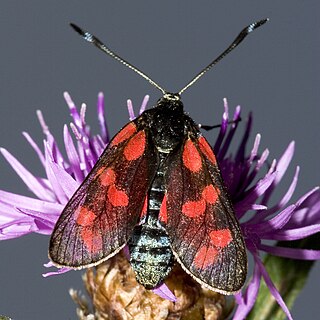Related Research Articles
Heterobathmia is a genus of Lepidoptera. It is the only genus in the suborder Heterobathmiina, as well as in the superfamily Heterobathmioidea and in the family Heterobathmiidae. Primitive, day-flying, metallic moths confined to southern South America, the adults eat the pollen of Nothofagus or southern beech and the larvae mine the leaves. Most known species are undescribed.

The Zygaenoidea comprise the superfamily of moths that includes burnet moths, forester moths, and relatives.

The Dalceridae are a small family of zygaenoid moths with some 80 known species encompassing about one dozen genera mostly found in the Neotropical region with a few reaching the far south of the Nearctic region.
Cyclotorna is a genus of moths, the sole one of family Cyclotornidae, with five recognized species, all endemic to Australia. This family and the closely related Epipyropidae are unique among the Lepidoptera in that the larvae are ectoparasites, the hosts in this case typically being leafhoppers, sometimes scale insects. The larvae of cyclotornids, however, leave the hemipteran host and become predatory on the brood in ant nests, apparently using chemical cues to induce the ants to carry the larvae into the ant nest.

The Epipyropidae comprise a small family of moths. This family and the closely related Cyclotornidae are unique among the Lepidoptera in that the larvae are ectoparasites, the hosts typically being fulgoroid planthoppers, thus the common name planthopper parasite moths.

The Thyatirinae, or false owlet moths, are a subfamily of the moth family Drepanidae with about 200 species described. Until recently, most classifications treated this group as a separate family called Thyatiridae.
Paraboarmia is a monotypic moth genus in the family Geometridae erected by F. Krampl in 1994. Its only species, Paraboarmia viertlii, the Bohatsch's lined, first described by Otto Bohatsch in 1883, is found in Europe.
Agamopsyche is a genus of moths in the family Epipyropidae. It consists of only one species Agamopsyche threnodes, which is found in Queensland.
Palaeopsyche is a genus of moths in the family Epipyropidae. It consists of only one species Palaeopsyche melanias, which is found in the wet tropics of Queensland.
Heteropsyche is a genus of moths in the Epipyropidae family.
Heteropsyche stenomorpha is a moth in the family Epipyropidae. It is found in Australia.
Protacraga is a genus of moths in the Epipyropidae family.
Epieurybrachys is a monotypic moth genus in the family Epipyropidae described by Kato in 1940. Its sole species, Epieurybrachys eurybrachydis, was described by Thomas Bainbrigge Fletcher in 1920. It is found in India.
Anopyrops is a monotypic moth genus in the family Epipyropidae. Anopyrops corticina, its sole species, was described by Karl Jordan in 1928 and is found in French Guiana and Suriname.

Epipomponia is a genus of moths in the Epipyropidae family.
Epiricania is a genus of moths in the family Epipyropidae described by Kato in 1939.
Ommatissopyrops is a genus of moths in the Epipyropidae family.
Epipyrops poligrapha is a moth of the family Epipyropidae.
References
- 1 2 Krampl, František; Dlabola, Jiří (1983). "A new genus and species of Epipyropid moth from Iran ectoparasitic on a new Mesophantia species, with a revision of the host genus (Lepidoptera, Epipyropidae; Homoptera, Flatidae)". Acta Entomologica Bohemoslovaca. 80 (6): 451–472. ISSN 0001-5601.
- ↑ Epimesophantia at funet
- ↑ Krampi
- ↑ LepIndex
| This article relating to the superfamily Zygaenoidea is a stub. You can help Wikipedia by expanding it. |